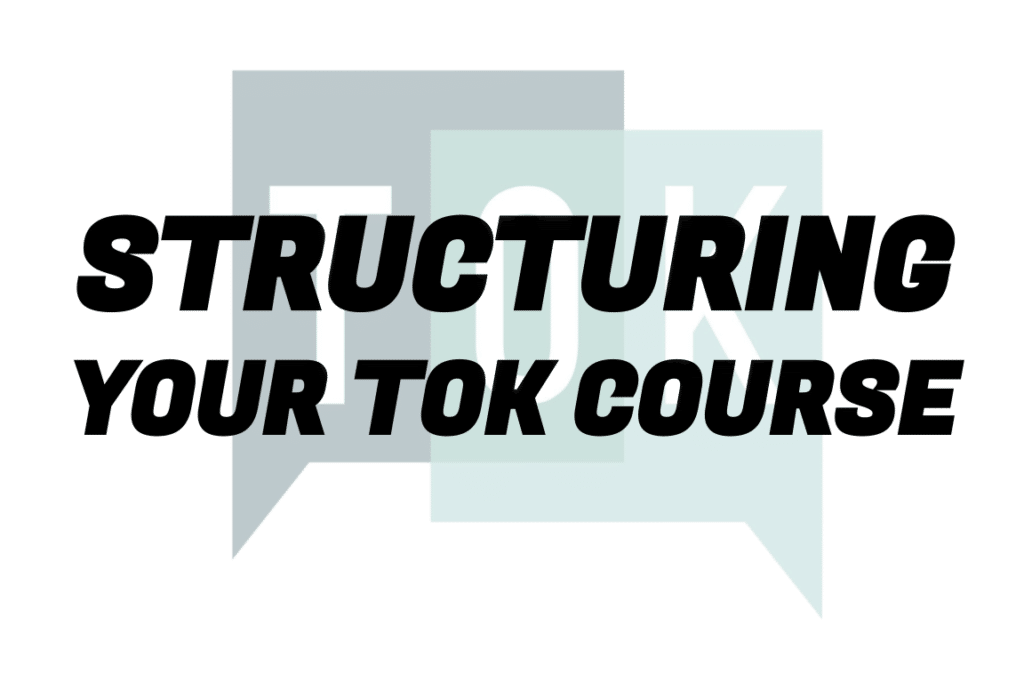
There are a number of ways you can structure an effective TOK course, either by basing your units directly on the areas of knowledge and themes, or making them more conceptual and question-driven.
The Big Questions: a question-based, conceptual structure to TOK
The BQs ask broad questions about knowledge, enabling us to consider the most essential aspects of how we understand the world. They give us a lens through which we can explore the world, and a way of teaching the course.

Big Question 1
BQ1 asks, “What is TOK, and why do we study it?” It looks at both the fundamentals of the course, and of knowledge itself. We consider most aspects of the course, paying particular attention to the core theme, knowledge and the knower. If you’re a member, you can access the BQ1 lessons here.

Big Question 2
BQ2 asks, “How does our knowledge about the world inform the way we construct our values?” It considers the relationship between the different AOKs and optional themes, and ethics. It looks at the arts, the natural sciences, and indigenous societies. Access the BQ2 lessons here.

Big Question 3
BQ3 asks, “How is our understanding of the world influenced by the way knowledge is communicated?” Our primary focus is on human sciences; we’ll also look at how both technology and language can shift our understanding. Access the BQ3 lessons here.

Big Question 4
BQ4 asks, “How do our perspectives and biases shape our knowledge about the world?” It looks at how we often seek to confirm our pre-existing ideas. History is the main focus, but we also think about the effect of religious and political perspectives. Access the BQ4 lessons here.

Big Question 5
BQ5 asks, “How is new knowledge about the world created?” It assesses how and why knowledge about the world changes over time. We’ll consider if language is being ‘dumbed down’, how science is provisional, and changes in the arts. Access the BQ5 lessons here.

Big Question 6
BQ6 asks, “How do we become discerning knowers?” It looks at what it takes to become a sophisticated knower about the world. Students revisit various lessons from earlier in the course, and develop a deeper understanding of their key concepts. Access the BQ6 lessons here.
What advantage does the BQ framework offer?
The BQ framework is similar to the knowledge framework, but it has distinct advantages over the traditional ‘shopping list’ approach to TOK, in which themes and AOKs are taught separately.
It provides a coherent structure to the TOK course
Each BQ asks a question about knowledge which provides us with a focus and direction, and encourages us to approach each element of the TOK course in an analytical, rather than descriptive, way. The BQs can be applied to all aspects of the course, and shift to suit the context of the theme or area of knowledge. All this means that students have a much clearer idea about content and purpose of TOK.
It enables us to approach the course in an integrated way
Each BQ requires an exploration via a combination of themes and areas of knowledge, rather than dealing with the different parts of the course in isolation (which gives us an artificial and contrived perception of knowledge). This gives students a more complete picture of both knowledge, and TOK, and interlink ideas and concepts more effectively.
It brings everyone onboard TOK
In addition to creating an integrated TOK course in itself, it also helps to create an integrated Diploma Programme. Every DP teacher can apply the BQs to their own subject, and play a role in TOK at any point during the course, not just when their subject is being covered. It also enables parents to get involved with TOK more easily, and support the intellectual development of their children.
It prepares students more effectively for the essay
The BQs were backward planned from many years of prescribed titles, so they provide the perfect preparation for writing the TOK essay. Rather than dreading the moment when you provide your students with the list of PTs, you’ll watch them instinctively relate the different PTs with the BQs, and make links with the lessons they’ve learned, rather than dwell on their dissonance from the titles.
It prepares students more effectively for the exhibition
You’ll also see a lot of overlap between the BQs and the IA prompts for the exhibition. Concepts such as values, perspectives, and spin, which we study explicitly during the BQ framework appear repeatedly throughout the 35 IA prompts, meaning that any student who has followed the BQ approach will feel very comfortable choosing the focus point for their exhibition.
It links TOK more naturally with the real world
We explore knowledge via real-life situations – events and issues going on in the world today, that may be local, regional, or global. Structuring a course via questions enable links to be made much more easily to those situations, and enables us to draw them into TOK in order to understand concepts and ideas that are central to the course.
How do the BQs work in practice?

The best way to see how the BQ units work in practice is to see our beautifully designed lessons for yourself. Download a sample selection of lessons and support material from the BQ framework on this page. If you have any questions about the resources, you can get in touch with us easily, and as a member, we are always on hand to provide support.

Become a member of theoryofknowledge.net
Members have access to a huge range of classroom-ready TOK resources, including three different TOK Courses, the monthly TOK Mini-Lessons, our TOK Padlets, the Integration Tool, TOK Filmography, and loads more engaging, innovative resources!
Join in seconds here, and turn your school into a hub of authentic critical thinking.